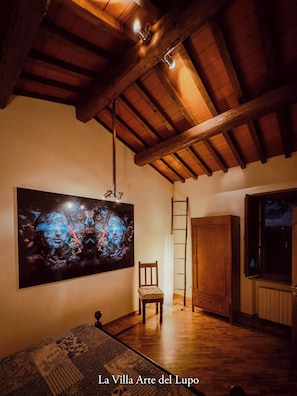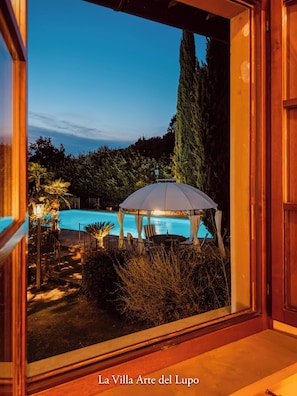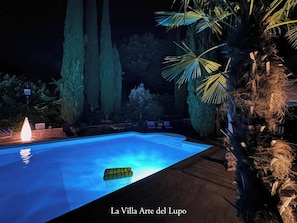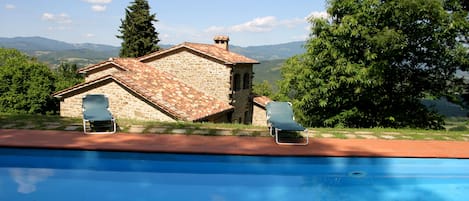Hel semesterbostad·Privat värd
Oasi del lupo ".La Villa ARTE del Lupo" Jewel in Tuscany near Arezzo
Villa vid floden med fitnesscenter och utomhuspool
Fotogalleri för Oasi del lupo ".La Villa ARTE del Lupo" Jewel in Tuscany near Arezzo





Recensioner
10 av 10,
Enastående
2 sovrum1 badrumSovplats för 470 kvm
Populära bekvämligheter
Utforska området

Subbiano, Arezzo
- Place, Piazza Grande30 min med bil
- Place, Arezzo Equestrian Centre36 min med bil
- Place, La Vernas helgedom41 min med bil
Rum och sängar
2 sovrum (sovplats för 4)
Sovrum 1
1 dubbelsäng
Sovrum 2
1 dubbelsäng
1 badrum
Badrum 1
Tvål · Handdukar tillhandahålles · Toalett · Endast dusch · Hårtork
Ytterligare utrymmen
Däck eller uteplats
Kök
Pentry
Trädgård
Matplats
Om boendet
Oasi del lupo ".La Villa ARTE del Lupo" Jewel in Tuscany near Arezzo
Welcome to our hidden gem in Tuscany! Our beautiful retreat offers the perfect combination of art and relaxation under one roof. Come and relax in our peaceful oasis and unwind.
The villa has four cuddly golden retrievers whose gentle nature will make you forget everyday life. 4000 sqm garden with pool in a fantastic panoramic location. The pool house is on the grounds of "La Villa ARTE del Lupo"
Subbiano is in the middle of the most important sights and is therefore perfect for day trips to many famous cities, such as Florence, Siena, Pisa, Volterra, Montepulciano, Perugia,
Lake Trasimeno, Castiglione del Lago, Citta di Castello. Drive to the famous Val di Chiana. Visit La Villa with its delicacies. All of these dream destinations can be reached in between 15 minutes and 1.5 hours.
Anyone who has a dream should go to Italy.
It doesn't matter if you think the dream is dead and buried,
in Italy it will rise again and come true
(Elizabeth Spencer)
The Villa del ARTE del Lupo – Not just a place to stay…
FROM WAYNE ANTHONY-08-2024
Nestled atop the rolling hills of Tuscany, the Villa del ARTE del Lupo offers not only a relaxing place to
stay, but a place where history, art, and mysticism converge in a glimpse of Italy’s historic past. The
property has served various purposes over its long life: a rest stop for travelers, a religious retreat, an
extensive family home, and now a place for guests to experience the beauty of Tuscany. While enjoying
a relaxing stay, however, guests should make time to explore the unique grounds, which, with open
eyes, give the keen observer a chance to explore a slice of the unique two-thousand year history of the
Italian countryside.
For the curious, consider a simple stroll around the property. Terraces carefully cut into the land provide
level areas for agriculture. Massive fig trees and orchards once offered fruit in their season. Cisterns,
now dry, attest to hidden Roman engineering. Traces of ancient lanes lead to hidden groves, pavilions,
and bowers, lost to the mysteries of time.
In fact, the approach to the Villa is one of the primary roads of ancient Rome, the Via Romea Germanica.
Around 1236 AD, this way transformed into a religious pilgrimage route linking Stade, Germany in the
north to the Vatican at Rome in the south. This historic road passes directly in front of the main Villa,
bisecting the land. Today, it is marked with two historical markers citing the mileage to either terminus.
Approaching the Villa from the south on this road and traveling up the hill, the land is lined with several
vineyards, fruit groves, and farms which originally provided food for the estate above. Aging
outbuildings still remain gently slipping away, a testament to effects of time. Small access lanes, now
wildly overgrown, wind away and lead to places long forgotten. As the house nears, on the left a storage
area, erected by a former owner, boasts stacked remains of historic stone work rescued from the
surrounding countryside. Upon arrival at the Villa, four unique markers clearly delineate the beginning
of the main compound.
The first of these sits to the right of the road, a large, arch-shaped stone. Protruding from its flat face, a
carved relief of an unknown pagan deity stands sentinel. Its features have been brutally defaced,
possibly in the Middle Ages, when the site was transformed from a pagan wayside to a Christian
nunnery, but its placement is clear. Even the early Romans sought the gods’ protection of their land.
On the left, across from the stone marker, sits the corner wall of the main entrance. Herein is set a
definitive reminder of the Christian conversion. An icon of Michael the Archangel defeating the Dragon
of Evil (Revelation 12:7 in the Bible), proclaims a notice of divine protection--no evil dare enter this
sacred site. In his hands, Michael wields a sword of victory and holds the scales of justice weighing the
hearts of all. His foot crushes the head of the defeated dragon.
Before the shrine is placed a kneeling plinth for prayer. To the right, a candle nook offers light to the way
of the pilgrims. Within the nook is the seal of the Grand Master of the Knight’s Templar, showing their
approval and use of the land as a safe haven for pilgrims. A Templer Knight with shield rides his steed;
circling is the Templar motto: Cristi sigillum militum (Seal of the Soldiers of Christ). Above, inscribed in
the plaster work, are the words “Io credo” (I believe). To the right of this sits an ambiguous symbol--a
circle with four petals, possibly a Greek Chi (the symbol of Christ) or a marker of the four Gospels
(Matthew, Mark, Luke, and John).
Continuing down the wall to the left of the icon, is another pair of markers. First, a half circle niche
which most likely held a statue of a local pagan god, is now bricked over. Then, a fresco triumvirate of
three women bathing naked in a spring, possibly water nymphs, is beside. In the far background of the
fresco, a depiction of the Villa can be seen. This enigmatic artwork stands in direct opposition to its
Christian neighbors--that is until entering the property through the passage just beside. Behind, not fifty
feet from the image is a well, a sacred spring. The fresco is a beacon for travelers on the road that there
is water for the thirsty weary available. This wellspring is likely an outlet of another amazing feature of
this property: through a variety of hidden underground waterways, the entire complex is feed water
directly from a hidden lake further up the hill
Finally, moving another twenty feet further down the entrance wall, is a final historical feature. Built
into the wall are the durchreiche, or ‘pass throughs.’ These two large, brick-lined circular openings date
from the time the property housed a cloistered nunnery. They allowed the surrounding community to
bring supplies to the Order, and pass these through to those cloistered and secluded within.
From this point, returning the Via Romane, the property unfolds. A tall stone wall lines the road to the
right. This creates a terrace on the hill above upon which sets the various buildings of the main property.
This wall opens to a car park beyond which and below lies a terraced planting area which most likely
served as kitchen garden for the medieval nunnery. Above this terrace, across the Roman road, is an
area which formed a meditation garden (not accessible as a part of the current property).
The rest of the complex consists of a sprawling number of buildings which have been adapted and
adorned by the work of the last previous owner. The grounds sport stoneware salvaged from the
surrounding countryside. Animals, water basins, and reclaimed building materials are artistically
incorporated everywhere and are worth a careful examination. Cast a glance upward as well, as the
stonework is even incorporate into the chimneys and roof features.
Finally, the four corners of main house’s eave are adorned with metal lilies, the symbol of
Easter—resurrection, hope, rebirth and blessing. This seems a curious addition until entering the
house’s kitchen. Just inside, a nook houses a painted icon of Mary holding Jesus. She keeps watch over
all who enter, and in his hands, the Christ Child holds a sprig of lilies, clearly the symbol of His blessing
and favor upon the house and all who enter.
Host:
Tammy and Ulli
About us
"Having fun in life is the best cosmetic for a woman."
Tammy a strong, beautiful woman at Ulli's side
Press release ULRICH HM WOLF:
Paris Hilton, Londonbeat, Natascha Wright (La Bouche) Thomas Anders, Weathergirls, Markus, Marjike Amado, Udo Jürgens and many others have been in front of the camera in his model villa in Taunusstein/Hessen and now Subbiano in Tuscany - that's where he likes to work most after his many travels. "The special, slow-paced, concentrated atmosphere in my refuge is often the basis for the extraordinary moment that needs to be shown," emphasizes photo psychologist and people expert Ulrich HM Wolf, who is unusually reserved for the media environment. A big city is not an option for his home base. After arriving from Berlin, London, NY, Milan, etc., it quickly becomes clear to everyone who comes for the first time: the warm atmosphere is unique and visible.?
The latest creation is called FACES - unique art portraits of predominantly famous faces.
The villa has four cuddly golden retrievers whose gentle nature will make you forget everyday life. 4000 sqm garden with pool in a fantastic panoramic location. The pool house is on the grounds of "La Villa ARTE del Lupo"
Subbiano is in the middle of the most important sights and is therefore perfect for day trips to many famous cities, such as Florence, Siena, Pisa, Volterra, Montepulciano, Perugia,
Lake Trasimeno, Castiglione del Lago, Citta di Castello. Drive to the famous Val di Chiana. Visit La Villa with its delicacies. All of these dream destinations can be reached in between 15 minutes and 1.5 hours.
Anyone who has a dream should go to Italy.
It doesn't matter if you think the dream is dead and buried,
in Italy it will rise again and come true
(Elizabeth Spencer)
The Villa del ARTE del Lupo – Not just a place to stay…
FROM WAYNE ANTHONY-08-2024
Nestled atop the rolling hills of Tuscany, the Villa del ARTE del Lupo offers not only a relaxing place to
stay, but a place where history, art, and mysticism converge in a glimpse of Italy’s historic past. The
property has served various purposes over its long life: a rest stop for travelers, a religious retreat, an
extensive family home, and now a place for guests to experience the beauty of Tuscany. While enjoying
a relaxing stay, however, guests should make time to explore the unique grounds, which, with open
eyes, give the keen observer a chance to explore a slice of the unique two-thousand year history of the
Italian countryside.
For the curious, consider a simple stroll around the property. Terraces carefully cut into the land provide
level areas for agriculture. Massive fig trees and orchards once offered fruit in their season. Cisterns,
now dry, attest to hidden Roman engineering. Traces of ancient lanes lead to hidden groves, pavilions,
and bowers, lost to the mysteries of time.
In fact, the approach to the Villa is one of the primary roads of ancient Rome, the Via Romea Germanica.
Around 1236 AD, this way transformed into a religious pilgrimage route linking Stade, Germany in the
north to the Vatican at Rome in the south. This historic road passes directly in front of the main Villa,
bisecting the land. Today, it is marked with two historical markers citing the mileage to either terminus.
Approaching the Villa from the south on this road and traveling up the hill, the land is lined with several
vineyards, fruit groves, and farms which originally provided food for the estate above. Aging
outbuildings still remain gently slipping away, a testament to effects of time. Small access lanes, now
wildly overgrown, wind away and lead to places long forgotten. As the house nears, on the left a storage
area, erected by a former owner, boasts stacked remains of historic stone work rescued from the
surrounding countryside. Upon arrival at the Villa, four unique markers clearly delineate the beginning
of the main compound.
The first of these sits to the right of the road, a large, arch-shaped stone. Protruding from its flat face, a
carved relief of an unknown pagan deity stands sentinel. Its features have been brutally defaced,
possibly in the Middle Ages, when the site was transformed from a pagan wayside to a Christian
nunnery, but its placement is clear. Even the early Romans sought the gods’ protection of their land.
On the left, across from the stone marker, sits the corner wall of the main entrance. Herein is set a
definitive reminder of the Christian conversion. An icon of Michael the Archangel defeating the Dragon
of Evil (Revelation 12:7 in the Bible), proclaims a notice of divine protection--no evil dare enter this
sacred site. In his hands, Michael wields a sword of victory and holds the scales of justice weighing the
hearts of all. His foot crushes the head of the defeated dragon.
Before the shrine is placed a kneeling plinth for prayer. To the right, a candle nook offers light to the way
of the pilgrims. Within the nook is the seal of the Grand Master of the Knight’s Templar, showing their
approval and use of the land as a safe haven for pilgrims. A Templer Knight with shield rides his steed;
circling is the Templar motto: Cristi sigillum militum (Seal of the Soldiers of Christ). Above, inscribed in
the plaster work, are the words “Io credo” (I believe). To the right of this sits an ambiguous symbol--a
circle with four petals, possibly a Greek Chi (the symbol of Christ) or a marker of the four Gospels
(Matthew, Mark, Luke, and John).
Continuing down the wall to the left of the icon, is another pair of markers. First, a half circle niche
which most likely held a statue of a local pagan god, is now bricked over. Then, a fresco triumvirate of
three women bathing naked in a spring, possibly water nymphs, is beside. In the far background of the
fresco, a depiction of the Villa can be seen. This enigmatic artwork stands in direct opposition to its
Christian neighbors--that is until entering the property through the passage just beside. Behind, not fifty
feet from the image is a well, a sacred spring. The fresco is a beacon for travelers on the road that there
is water for the thirsty weary available. This wellspring is likely an outlet of another amazing feature of
this property: through a variety of hidden underground waterways, the entire complex is feed water
directly from a hidden lake further up the hill
Finally, moving another twenty feet further down the entrance wall, is a final historical feature. Built
into the wall are the durchreiche, or ‘pass throughs.’ These two large, brick-lined circular openings date
from the time the property housed a cloistered nunnery. They allowed the surrounding community to
bring supplies to the Order, and pass these through to those cloistered and secluded within.
From this point, returning the Via Romane, the property unfolds. A tall stone wall lines the road to the
right. This creates a terrace on the hill above upon which sets the various buildings of the main property.
This wall opens to a car park beyond which and below lies a terraced planting area which most likely
served as kitchen garden for the medieval nunnery. Above this terrace, across the Roman road, is an
area which formed a meditation garden (not accessible as a part of the current property).
The rest of the complex consists of a sprawling number of buildings which have been adapted and
adorned by the work of the last previous owner. The grounds sport stoneware salvaged from the
surrounding countryside. Animals, water basins, and reclaimed building materials are artistically
incorporated everywhere and are worth a careful examination. Cast a glance upward as well, as the
stonework is even incorporate into the chimneys and roof features.
Finally, the four corners of main house’s eave are adorned with metal lilies, the symbol of
Easter—resurrection, hope, rebirth and blessing. This seems a curious addition until entering the
house’s kitchen. Just inside, a nook houses a painted icon of Mary holding Jesus. She keeps watch over
all who enter, and in his hands, the Christ Child holds a sprig of lilies, clearly the symbol of His blessing
and favor upon the house and all who enter.
Host:
Tammy and Ulli
About us
"Having fun in life is the best cosmetic for a woman."
Tammy a strong, beautiful woman at Ulli's side
Press release ULRICH HM WOLF:
Paris Hilton, Londonbeat, Natascha Wright (La Bouche) Thomas Anders, Weathergirls, Markus, Marjike Amado, Udo Jürgens and many others have been in front of the camera in his model villa in Taunusstein/Hessen and now Subbiano in Tuscany - that's where he likes to work most after his many travels. "The special, slow-paced, concentrated atmosphere in my refuge is often the basis for the extraordinary moment that needs to be shown," emphasizes photo psychologist and people expert Ulrich HM Wolf, who is unusually reserved for the media environment. A big city is not an option for his home base. After arriving from Berlin, London, NY, Milan, etc., it quickly becomes clear to everyone who comes for the first time: the warm atmosphere is unique and visible.?
The latest creation is called FACES - unique art portraits of predominantly famous faces.
Lägg till datum för priser
Bekvämligheter
Pool
Kök
Tvättmaskin
Torktumlare
Gratis wi-fi
Luftkonditionering
Liknande boenden

Villa I Cipressi by fewo-toskana, surrounded by nature, secluded location, private pool, barbecue
Villa I Cipressi by fewo-toskana, surrounded by nature, secluded location, private pool, barbecue
- Husdjursvänligt
Husregler
Incheckning efter 16.00
Lägsta ålder för att hyra: 18 år
Utcheckning före 12.30
Barn
Endast vuxna
Evenemang
Inga evenemang tillåts
Husdjur
Inga husdjur tillåts
Rökning tillåten
Rökning tillåten i avsedda områden
Viktig information
Att hålla koll på
Detta boende drivs av en privat värd (någon som inte agerar inom sin företagsverksamhet eller sitt yrke). EU:s konsumentlagar, inklusive ångerrätten, gäller inte för din bokning. Din bokning omfattas av den privata värdens avbokningspolicy.
Avgifter för extragäster kan tillkomma och varierar i enlighet med boendets policy.
Statligt utfärdad fotolegitimation och kreditkort, bankkort eller kontantdeposition kan krävas vid incheckning för oförutsedda utgifter.
Särskilda önskemål erbjuds i mån av tillgång vid incheckning och kan medföra ytterligare avgifter. Särskilda önskemål kan inte garanteras.
Fester och gruppevenemang är inte tillåtna på boendet.
Värden har inte angett om det finns någon kolmonoxidvarnare på boendet. Överväg att ta en bärbar varnare med dig på resan.
Värden har angett att det finns en rökdetektor på boendet.
Boendets registreringsnummer IT051002C235ZRT9KL
Bra att veta
Alla gäster, även barn, måste vara närvarande vid incheckning och uppvisa statligt utfärdad legitimation eller pass.
Kontanttransaktioner på boendet får inte överstiga EUR 5000, på grund av statliga bestämmelser. Du kan få mer information genom att kontakta boendet via kontaktuppgifterna i bokningsbekräftelsen.
Om området
Subbiano
Denna villa ligger på landet och vid floden i Subbiano. Fioraia-slottet och Castelnuovo di Subbiano (slott) är lokala sevärdheter, och bland områdets turistattraktioner hittar du Ravagni oljekvarn och Fattoria La Vialla.

Subbiano, Arezzo
I närheten
- Ospedale San Donato - 30 min med bil - 20.7 km
- Piazza Grande - 30 min med bil - 19.6 km
- Arezzo Equestrian Centre - 36 min med bil - 27.8 km
- La Vernas helgedom - 41 min med bil - 27.1 km
- Valdichiana - 51 min med bil - 57.7 km
Ta sig runt
Restauranger
- La Corte dell'Oca - 30 min med bil
- Castello Di Valenzano - 40 min med bil
- Ristorante Chenno - 30 min med bil
- Bar Il Portico - 39 min med bil
- Pasticceria Caffetteria Bardelli - 30 min med bil
Vanliga frågor och svar
Om värden
Ulrich Wolf är värd
Språk:
Engelska, Tyska
Har du några förslag på hur vi kan förbättra sidan?Ge feedback




